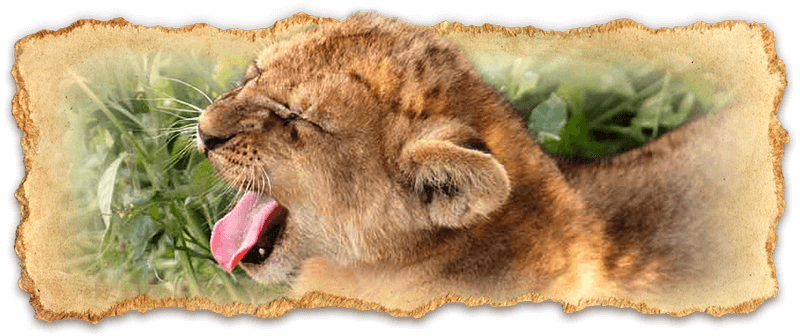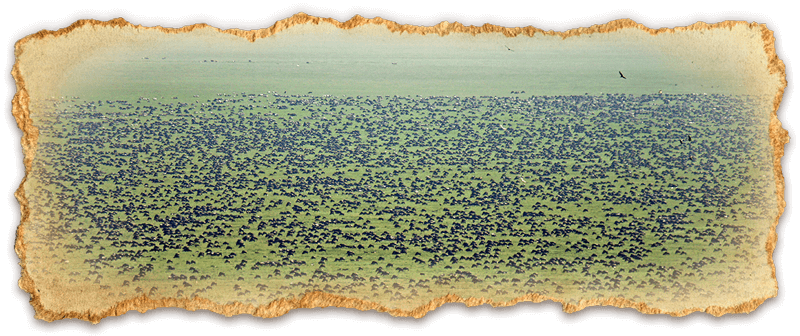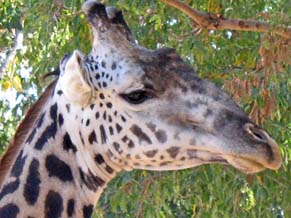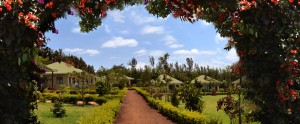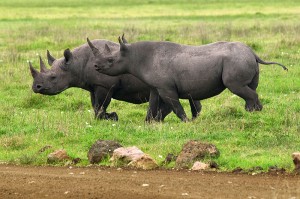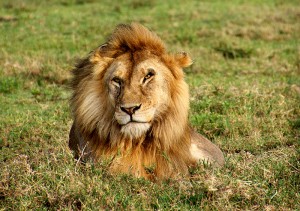Ndutu Wildebeest Migration Escape
~ Deluxe ~
~ Deluxe ~
The best season for this departure is mid-December—March
Safari Overview
While enjoying deluxe accommodations, our Deluxe Ndutu Wildebeest Migration Safari lends the opportunity to witness the massive herds of wildebeest migration in the Southeast Plains of Serengeti, as well as discover the abundant wildlife in the northern parks of Tanzania.
9 days
8 nights
- Safari Highlights:
- Witness the Great Wildebeest Migration in the Ndutu Plains of Southeast Serengeti.
- See tons of pink flamingos in Arusha National Park.
- Observe a ground water forest which is home to enormous troops of baboons and tree-climbing lions in Lake Manyara National Park.
- Discover local culture and participate on a village walk, school visit and farmers market.
- Capture the abundance and diversity of wildlife including the rare black rhino in the Ngorongoro Crater.
- Behold the “Cradle of Mankind,” Olduvai Gorge.
- Enjoy 3-overnights and 2.5-days of game drive in the expanse of Serengeti.
Itinerary
Deluxe Ndutu Wildebeest Migration Safari: Discover Northern Tanzania
Day 1
Arrive in Arusha, Tanzania
You will arrive Kilimanjaro International Airport (JRO) by your international flight. Your driver guide will meet you at you at the airport and drive you to Kibo Palace Hotel (or similar) for overnight (Bed & Breakfast).
About Kibo Palace Hotel
Day 2
A Game Drive Day
Drive to Arusha National Park with picnic lunch for a full-day game drive. Dinner and overnight will be at Kibo Palace Hotel (or similar).
About Arusha National Park
Day 3
Manyara National Park
Drive to Lake Manyara National Park for a game drive and a picnic lunch. Dinner and overnight will be at Country Lodge (or similar).
About Manyara National Park
About Country Lodge
Day 4
Discover Local Culture
After breakfast, go on a village walk with a school visit. At noon, return to your lodge for lunch. In late afternoon, visit a farmers market. Dinner and overnight will be at Country Lodge (or similar).
About Local Culture
Day 5
Ngorongoro Crater and a Leisurely Evening
At 6:30 AM, drive to Ngorongoro Crater for an early morning game drive with a picnic lunch. In late afternoon, return to your lodge for an evening at leisure. Dinner and overnight will be at Country Lodge (or similar).
About Ngorongoro Crater
Day 6
Olduvai Gorge and Ndutu Plains
Drive to Ndutu Safari Lodge in the Southern Serengeti for a picnic lunch. On the way, visit Olduvai Gorge Museum. In the afternoon, journey on with a game drive towards the Ndutu Plains in search of wildebeest migration. Dinner and overnight will be at Ndutu Safari Lodge (or similar).
About Southern Serengeti (Ndutu Plains)
About Serengeti National Park
About Olduvai Gorge Museum
About Ndutu Safari Lodge
Day 7
Game Drives in the Southern Serengeti
The search for wildebeest migration continues with morning and afternoon game drives. Dinner and overnight will be at Ndutu Safari Lodge (or similar).
About The Great Migration
Day 8
Wildebeest Migration in the Serengeti
Morning and afternoon game drives press on in search of wildebeest migration. Dinner and overnight will be at Ndutu Safari Lodge (or similar).
Day 9
Return Flight to Arusha
After breakfast, enjoy a bird’s-eye view flight over Northern Tanzania, en route back to Arusha. Lunch and a dayroom will be at Kibo Palace Hotel. In the evening, transfer to Kilimanjaro International Airport (JRO) for your international flight back home.
- Inclusions:
- Respective accommodations or similar throughout as indicated.
- All meals on main tour as shown (except Day 1 at Bed & Breakfast).
- All game drives with photographic roof hatch land cruiser operated by a professional driver guide.
- All transfers as per the itinerary.
- Complimentary bottled water during game drives.
- Tips to waiters.
- All national park entry fees and Olduvai Museum entry fee.
- Visit to Maasai Village.
- Local flight from Southeast Serengeti to Arusha.
- Exclusions:
- Entry VISA and local airport tax.
- Personal and baggage insurance.
- Excess baggage charges levied by airline.
- Meals and beverages other than specified.
- Tips to your driver guide.
- Tips to porters.
- Cost for anything not mentioned on the list above.
Accommodations
Our Deluxe Ndutu Wildebeest MigrationSafari Features Deluxe Accommodations
Kibo Palace Hotel - Arusha
Named after the highest peak of Africa’s highest mountain – Mt Kilimanjaro, Kibo Palace Hotel is one of Arusha’s most exciting and innovative luxury hotels; contemporary, conductive and unconventional, a luxury hotel with a new attitude. Located in the heart of Arusha, gateway to the world’s most renowned game parks, it is a 45-minute drive from Kilimanjaro International Airport (JRO) and a 15-minute walk from Arusha city center and the Arusha International Conference Center. [learn more]
Country Lodge - Karatu (and Near Ngorongoro Area)
Country Lodge Karatu symbolizes simple country comforts, providing pleasant and affordable lodging in the heart of Tanzania’s rich and scenic highlands. Our lodge sits within five acres nestled on the edge of Karatu town, surrounded by rolling plains reaching up to the coffee hills of Oldeani and the forests’ of Ngorongoro. Garden paths led to eleven double cottages surrounded by green lawns, hedged by brightly flowered bougainvillaea, tropical plants and trees. Come and enjoy the tranquillity, home comforts and warm Tanzanian hospitality that Country Lodge offers. [learn more]
Ndutu Safari Lodge - Serengeti National Park
Built in 1960's by hunter George Dove, this lodge is located in the Ngorongoro Conservation Area near South-eastern Serengeti. It's a prime location to view the breeding grounds of thousands of Wildebeest. Ndutu Safari Lodge consists of 34 en-suite stone cottages - each with it’s own verandah that overlooks Lake Ndutu - and extend from the central, open-sided bar, lounge and dining room. Among the rooms are 10 doubles, 5 triples, and 1 familty room (accommodating up to 2 adults and 2 children). [learn more]
Named after the highest peak of Africa’s highest mountain – Mt Kilimanjaro, Kibo Palace Hotel is one of Arusha’s most exciting and innovative luxury hotels; contemporary, conductive and unconventional, a luxury hotel with a new attitude. Located in the heart of Arusha, gateway to the world’s most renowned game parks, it is a 45-minute drive from Kilimanjaro International Airport (JRO) and a 15-minute walk from Arusha city center and the Arusha International Conference Center. [learn more]
Country Lodge - Karatu (and Near Ngorongoro Area)
Country Lodge Karatu symbolizes simple country comforts, providing pleasant and affordable lodging in the heart of Tanzania’s rich and scenic highlands. Our lodge sits within five acres nestled on the edge of Karatu town, surrounded by rolling plains reaching up to the coffee hills of Oldeani and the forests’ of Ngorongoro. Garden paths led to eleven double cottages surrounded by green lawns, hedged by brightly flowered bougainvillaea, tropical plants and trees. Come and enjoy the tranquillity, home comforts and warm Tanzanian hospitality that Country Lodge offers. [learn more]
Ndutu Safari Lodge - Serengeti National Park
Built in 1960's by hunter George Dove, this lodge is located in the Ngorongoro Conservation Area near South-eastern Serengeti. It's a prime location to view the breeding grounds of thousands of Wildebeest. Ndutu Safari Lodge consists of 34 en-suite stone cottages - each with it’s own verandah that overlooks Lake Ndutu - and extend from the central, open-sided bar, lounge and dining room. Among the rooms are 10 doubles, 5 triples, and 1 familty room (accommodating up to 2 adults and 2 children). [learn more]
Destinations
Discover the World's Abundant Wildlife in Northern Tanzania
Arusha National Park
The entrance gate leads into shadowy montane forest inhabited by inquisitive Blue monkeys and colourful turacos and trogons – the only place on the northern safari circuit where the Black-and-White Colobus Monkey is easily seen. Further north, rolling grassy hills enclose the tranquil beauty of the Momela Lakes, each one a different hue of green or blue. Their shallows sometimes tinged pink with thousands of flamingos, the lakes support a rich selection of resident and migrant water-fowl, and shaggy waterbucks display their large lyre-shaped horns on the watery fringes. Giraffes glide across the grassy hills, between grazing zebra herds, while pairs of wide-eyed dik-dik dart into scrubby bush like overgrown hares on spindly legs.
It is also at dusk and dawn that the veil of cloud on the eastern horizon is most likely to clear, revealing the majestic snow-capped peaks of Kilimanjaro, 50km (30 miles) distant.
But it is Kilimanjaro’s unassuming cousin, Mount Meru–the fifth highest in Africa at 4566 metres above sea level (14990 feet) – that dominates the park’s horizon. Its peaks and eastern footslopes protected within the national park, Meru offers unparalleled views of its famous neighbor, while also forming a rewarding hiking destination in its own right.
The compact game –viewing circuit through Manyara offers a virtual microcosm of the Tanzanian safari experience. From the entrance gate, the road winds through an expanse of lush jungle like groundwater forest where hundred-strong baboon troops lounge nonchalantly along the roadside, Blue monkeys scamper nimbly between the ancient Mahogany trees, dainty Bushbuck tread warily through the shadows, and outsized forest hornbills honk in the high canopy.
Contrasting with the intimacy of the forest is the grassy floodplain and its expansive views eastward across the Alkakine Lake. Large buffalo, wildebeest and zebra herds congregate on these grassy plains, as do giraffes some so dark in coloration that they appear to be black from a distance.
Manyara provides the perfect introduction to Tanzania’s birdlife. More than 400 species have been recorded, and even a first-time visitor to Africa might reasonably expect to observe 100 of these in one day. Highlights include thousands of pink-hued flamingos on their perpetual migration, as well as other large waterbirds such as pelicans, cormorants and storks.
The village walk enables travelers to experience some local culture, people life and their respective activities. This may include visiting a School, Hospital, local Brick Making Centre, a Church, and more.
Farmers Market
This is a stop where our guests can visit a local Farmers Market to see different local produce that are being sold.
Ngorongoro Crater
The Ngorongoro Crater is only 3% of the total area of Ngorongoro Conservation Area (NCA), but it is home to more than 75% of all the game animals found in NCA. Technically known as a caldera, Ngorongoro crater is the largest unflooded and unbroken caldera in the world with 19.2 km in diameter, 2000 feet deep, and 102 sq miles in area. The rich pasture and permanent water of the crater floor supports a large resident population of wildlife of up to 25,000 predominantly grazing animals. These include wildebeest, zebra, buffalo, kongoni, gazelle, warthog and eland. The swamps and forest provide additional resources for hippo, elephant, waterbuck, reedbuck, and bushbuck, baboons and Vervet monkeys. The steep inner slopes provide habitat for dik-dik and the rare Mountain reedbuck.
Jackals thrive in the crater and bat-eared foxes live in the short grass area. Predatory animals such as lion, leopard, cheetah and serval cats live off the abundant wildlife; and large packs of hyenas roam the crater, making their own kills and scavenging from others. The crater is a dynamic and constantly changing ecosystem and the numbers and proportion of some animals including lions and Black rhinos have fluctuated considerably over the past 30 years. Thanks to anti-poaching patrols in the crater and the whole ecosystem, the Black rhino population is coming back. Ngorongoro crater is one of the few places in East Africa where visitors can see a rhino. [learn more]
Ndutu Plains (Southern Serengeti)
Serengeti means endless plain in the Maasai language. The southern plain is where this name comes from. The vast grassy plains stretch as far as your eyes can see. It is in the southeast plain of Serengeti where the expanse herds of wildebeest migration stay from December through April. 90% of adult female wildebeest give birth in this plain during February. During this time predators such as lions, cheetahs and hyenas are seen in good numbers as their prey is in abundance.
Serengeti National Park
Tanzania’s oldest and most popular national park, also a World Heritage Site and also proclaimed a Worldwide Wonder, the Serengeti is famed for its annual migration, when some two million hooves pound the open plains, as more than 200,000 zebra and 300,000 Thomson’s gazelle join the wildebeest’s trek for fresh grazing. Yet even when the migration is quiet, the Serengeti offers arguably the most scintillating game-viewing in Africa: great herds of buffalo, smaller groups of elephant and giraffes, and hundreds upon hundreds of eland, topi, kongoni, impala and Grant's gazelle.
The spectacle of predators versus prey dominates Tanzania's greatest park. Golden–mained lion prides feast on the abundance of plain grazers. Solitary leopards haunt the Acacia trees lining the Seronera River, while high densities of cheetahs prowling the southeastern plains. Almost uniquely, all three African jackal species occur here, alongside the Spotted hyena and a host of more elusive small predators, ranging from the insectivorous aardwolf to the beautiful serval cat.
But there is more to Serengeti than large mammals. 500–plus bird species, ranging from the outsized ostrich and bizarre secretary bird of the open grass-land, to the Black eagles that soar effortlessly above the Lobo Hills.
Laetoli is found west of Ngorongoro Crater. It is here where hominid footprints are preserved in volcanic rock 3.6 million years old and represent some of the earliest signs of mankind in the world. Excavation, mainly by the archaeologists Louis and Mary Leakey, yielded four different kinds of hominid, showing a gradual increase in brain size and in the complexity of their stone tools. The first skull of Zinjanthropus, commonly known as the "Nutcracker Man”, who lived about 1.75 million years ago was found here. [learn more]
The Great Migration
Each year around the same time, the circular great wildebeest migration begins in the Ngorongoro Conservation Area of the southern Serengeti in Tanzania. This migration is a natural phenomenon determined by the availability of grazing. [learn more]
The entrance gate leads into shadowy montane forest inhabited by inquisitive Blue monkeys and colourful turacos and trogons – the only place on the northern safari circuit where the Black-and-White Colobus Monkey is easily seen. Further north, rolling grassy hills enclose the tranquil beauty of the Momela Lakes, each one a different hue of green or blue. Their shallows sometimes tinged pink with thousands of flamingos, the lakes support a rich selection of resident and migrant water-fowl, and shaggy waterbucks display their large lyre-shaped horns on the watery fringes. Giraffes glide across the grassy hills, between grazing zebra herds, while pairs of wide-eyed dik-dik dart into scrubby bush like overgrown hares on spindly legs.
It is also at dusk and dawn that the veil of cloud on the eastern horizon is most likely to clear, revealing the majestic snow-capped peaks of Kilimanjaro, 50km (30 miles) distant.
But it is Kilimanjaro’s unassuming cousin, Mount Meru–the fifth highest in Africa at 4566 metres above sea level (14990 feet) – that dominates the park’s horizon. Its peaks and eastern footslopes protected within the national park, Meru offers unparalleled views of its famous neighbor, while also forming a rewarding hiking destination in its own right.
- Location: 335km (208 miles) from Arusha, stretching north to Kenya and bordering Lake Victoria to the west
- What to do: Hot-air balloon safaris, game viewing. Visit neighbouring Lake Victoria and Olduvai Gorge
- Best seasons to visit:
- December–June to see the wildebeest migration
- June–October to see resident animals and predators (however, mid-March/April is the peak of the rain season)
- Learn more
The compact game –viewing circuit through Manyara offers a virtual microcosm of the Tanzanian safari experience. From the entrance gate, the road winds through an expanse of lush jungle like groundwater forest where hundred-strong baboon troops lounge nonchalantly along the roadside, Blue monkeys scamper nimbly between the ancient Mahogany trees, dainty Bushbuck tread warily through the shadows, and outsized forest hornbills honk in the high canopy.
Contrasting with the intimacy of the forest is the grassy floodplain and its expansive views eastward across the Alkakine Lake. Large buffalo, wildebeest and zebra herds congregate on these grassy plains, as do giraffes some so dark in coloration that they appear to be black from a distance.
Manyara provides the perfect introduction to Tanzania’s birdlife. More than 400 species have been recorded, and even a first-time visitor to Africa might reasonably expect to observe 100 of these in one day. Highlights include thousands of pink-hued flamingos on their perpetual migration, as well as other large waterbirds such as pelicans, cormorants and storks.
- Location: The entrance gate lies 1.5 hours (126km/80 miles) west of Arusha along a newly surfaced road, close to the ethnically diverse market town of Mto Wa Mbu.
- What to do: Game drives and night game drives, cultural tours, mountain bike outside the park, walking safari inside the park.
- Best time: Dry season (July-October) for large mammals; wet season (November-June) for bird watching, the waterfalls and canoeing.
- Learn more
The village walk enables travelers to experience some local culture, people life and their respective activities. This may include visiting a School, Hospital, local Brick Making Centre, a Church, and more.
Farmers Market
This is a stop where our guests can visit a local Farmers Market to see different local produce that are being sold.
Ngorongoro Crater
The Ngorongoro Crater is only 3% of the total area of Ngorongoro Conservation Area (NCA), but it is home to more than 75% of all the game animals found in NCA. Technically known as a caldera, Ngorongoro crater is the largest unflooded and unbroken caldera in the world with 19.2 km in diameter, 2000 feet deep, and 102 sq miles in area. The rich pasture and permanent water of the crater floor supports a large resident population of wildlife of up to 25,000 predominantly grazing animals. These include wildebeest, zebra, buffalo, kongoni, gazelle, warthog and eland. The swamps and forest provide additional resources for hippo, elephant, waterbuck, reedbuck, and bushbuck, baboons and Vervet monkeys. The steep inner slopes provide habitat for dik-dik and the rare Mountain reedbuck.
Jackals thrive in the crater and bat-eared foxes live in the short grass area. Predatory animals such as lion, leopard, cheetah and serval cats live off the abundant wildlife; and large packs of hyenas roam the crater, making their own kills and scavenging from others. The crater is a dynamic and constantly changing ecosystem and the numbers and proportion of some animals including lions and Black rhinos have fluctuated considerably over the past 30 years. Thanks to anti-poaching patrols in the crater and the whole ecosystem, the Black rhino population is coming back. Ngorongoro crater is one of the few places in East Africa where visitors can see a rhino. [learn more]
Ndutu Plains (Southern Serengeti)
Serengeti means endless plain in the Maasai language. The southern plain is where this name comes from. The vast grassy plains stretch as far as your eyes can see. It is in the southeast plain of Serengeti where the expanse herds of wildebeest migration stay from December through April. 90% of adult female wildebeest give birth in this plain during February. During this time predators such as lions, cheetahs and hyenas are seen in good numbers as their prey is in abundance.
Serengeti National Park
Tanzania’s oldest and most popular national park, also a World Heritage Site and also proclaimed a Worldwide Wonder, the Serengeti is famed for its annual migration, when some two million hooves pound the open plains, as more than 200,000 zebra and 300,000 Thomson’s gazelle join the wildebeest’s trek for fresh grazing. Yet even when the migration is quiet, the Serengeti offers arguably the most scintillating game-viewing in Africa: great herds of buffalo, smaller groups of elephant and giraffes, and hundreds upon hundreds of eland, topi, kongoni, impala and Grant's gazelle.
The spectacle of predators versus prey dominates Tanzania's greatest park. Golden–mained lion prides feast on the abundance of plain grazers. Solitary leopards haunt the Acacia trees lining the Seronera River, while high densities of cheetahs prowling the southeastern plains. Almost uniquely, all three African jackal species occur here, alongside the Spotted hyena and a host of more elusive small predators, ranging from the insectivorous aardwolf to the beautiful serval cat.
But there is more to Serengeti than large mammals. 500–plus bird species, ranging from the outsized ostrich and bizarre secretary bird of the open grass-land, to the Black eagles that soar effortlessly above the Lobo Hills.
- Location: 335km (208 miles) from Arusha, stretching north to Kenya and bordering Lake Victoria to the west
- What to do: Hot-air balloon safaris, game viewing. Visit neighbouring Lake Victoria, Olduvai Gorge
- Best seasons to visit:
- December–June to see the wildebeest migration
- June–October to see resident animals and predators (however, mid-March/April is the peak of the rain season)
- Learn more
Laetoli is found west of Ngorongoro Crater. It is here where hominid footprints are preserved in volcanic rock 3.6 million years old and represent some of the earliest signs of mankind in the world. Excavation, mainly by the archaeologists Louis and Mary Leakey, yielded four different kinds of hominid, showing a gradual increase in brain size and in the complexity of their stone tools. The first skull of Zinjanthropus, commonly known as the "Nutcracker Man”, who lived about 1.75 million years ago was found here. [learn more]
The Great Migration
Each year around the same time, the circular great wildebeest migration begins in the Ngorongoro Conservation Area of the southern Serengeti in Tanzania. This migration is a natural phenomenon determined by the availability of grazing. [learn more]
Yes, I'm interested!
Have questions? Ready to book? Drop us a line and we'll get right back with you!
Use this form to book the Deluxe Ndutu Wildebeest Migration Escape.
You may customize a Signature Safari Itinerary to your liking, or simply design an itinerary from scratch!

